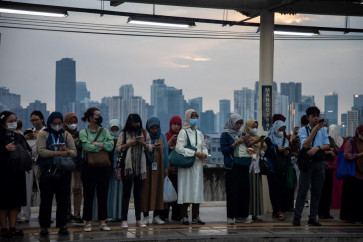Popular Reads
Top Results
Can't find what you're looking for?
View all search resultsPopular Reads
Top Results
Can't find what you're looking for?
View all search resultsAnalysis: Surge in internet users another good sign
The low level of internet use has been a worrying sign for years in this country, Asia’s fourth-largest economy
Change text size
Gift Premium Articles
to Anyone
T
he low level of internet use has been a worrying sign for years in this country, Asia’s fourth-largest economy.
Right through 2009, it looked like Indonesia was going to leap-frog past the conventional internet connection
and the personal computer, right through to the web via the mobile phone. The problem with that, and I
can’t prove it, is that reading as a habit would die an almost certain death. And if a country isn’t reading, it isn’t
becoming more clever. That’s what I think, I hope you agree.
Anybody who argues that you can “read” a newspaper article or a book on a mobile phone shouldn’t just get
his or her eyes examined. A small screen is more than adequate to tic-tac or “Facebook-an” as the new
Bahasa Indonesia slang goes, but try reading a few pages of the Encyclopaedia Brittanica on your phone.
You could do so, quite comfortably, on your computer or notebook screen. On a fl atscreen or bigscreen TV, it would be even more of a pleasure. Anybody who suggests that the encyclopaedia is a thing of the past is of course a threat to society, nothing less. At Roy Morgan Research, we can see what the country is watching,
over time. We are pleased to report that Indonesia’s future reading is looking good. That’s because the number of people with all three sizes of screens — the small one in the pocket, the medium-sized one on the desk as well as the big one in the living room — are all growing steadily. We’ve been reporting that happy phenomenon for some time, now we’re happy to say with total confi dence that the internet will not pass Indonesia by.
Internet use, at home, the office or the school has been abysmally low. For years, only about 1 percent
of the population had access to the internet from home or at work. Now “internet at home” has overtaken
“internet at work” for the first time, with over 3 percent of the population using it regularly. All of that rapid growth has materialized in the last four quarters.
Now it looks like free-market competition has been working its wonders again. Almost all of that spectacular
growth has come from the portable USB modem. Bundling internet access with the mobile phone connection
has worked well for all the telcos who’ve offered the combination. Looking for new avenues for revenue
growth, the country’s telecommunications giants have made portable internet access more and more attractive
throughout 2010. The price barrier has been coming down steadily and the consumers have been racing
in through the showroom doors. The competitive squeeze on voice and data costs is finally opening the door
wide to the Internet.
That rate of climb isn’t showing any signs of slowing down either. Some 10 million people own a personal computer today. Over 4 million people want to buy one in the next 12 months. Some 4 million people have an internet connection at home today. Over 2 million more are intending to get an internet connection at home. Even if intention doesn’t become reality for some, that’s more dramatic growth in store for Indonesia in the year ahead.
That demand is coming from just about everywhere. Men are more keen than women, urban is of course more eager than rural. For now. But as we’ve seen in the last five years, from the explosive charge forward in mobile telephony, women and rural folk wont be too far behind for too long in the realm of the internet either. If we focused on just the trend-setting Top 20 cities that will pave the way to a websavvy Indonesia, we would see that the largest single age group intending to get an internet connection at home are the 18-24 year olds, over
500,000 of them. They are closely followed by over 400,000 in the 25-34 age bracket, then the 35-49 year olds with another 350,000 intenders. The 200,000 from the 14-17 year age group and the 120,000 from the 50 and over would add up to another 320,000 households with parents paying the bill for the young aspirants. Altogether, these 1.7 million intenders from different households in the Top 20 cities would connect more internet homes for the first time than there are in all of neighboring Singapore. That kind of growth would then continue, well into the next decade.
Such developments are of critical importance to this very large country. The conversation must move on, from self-suffi ciency in rice production and growth in mineral exports, to the digital age. Indonesia has been lagging too far behind its neighbors for too long, to a point where it risked being a laggard permanently. That course correction is in process now, with market forces engineering the change in direction. With growing demand for Indonesian content, the local internet industry will finally get the critical mass it has needed to blossom. In
the coming years, expect to see a whole new industry make its mark. From venture capitalists and internet
entrepreneurs to web designers and application developers, a new generation will spring to life in Indonesia. They will help make improvements in the quality of just about everything: education, healthcare, commerce.
The cynics will of course cast many an aspersion. The too-slow-too-often speeds will attract much of the scorn.
Then, the high costs. Personally, I believe those who could afford the modem and the router yesterday are the
people who will be subsidising those who will get connected via their lowcost portable USB modems, tomorrow.
So be it. Together, we’ve all got a lot to gain from a country that will finally join the limitless, borderless
world that the internet alone can bring home to many more millions across the vast archipelago.
These observations are based on Roy Morgan Research. It is the country’s largest syndicated survey with over 25,000 respondents annually, projected to refl ect 90 percent of the population over the age of 14. The insights
are updated every 90 days.
The writer can be contacted at debnath.guharoy@roymorgan.com










